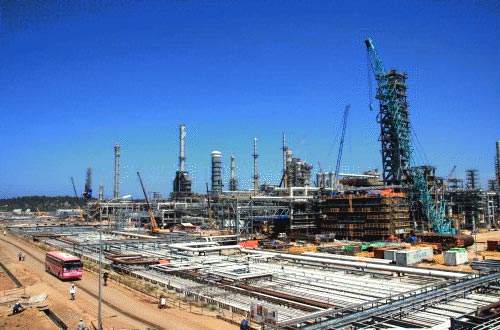River basins across the world are rich in oil and gas reserves. The Red River basin in the northern region of Vietnam also has large oil and gas reserves. The recent discovery of 50 billion cubic metres of natural gas and 45 million barrels of condensate at Hac Long field (Black Dragon) in the Red River basin proves the point. All of Vietnam’s existing oil and gas production lies off the southern coast. To raise oil and gas output, PetroVietnam has been stepping up efforts to find oil and gas in the central and northern regions.
PetroVietnam, established in 1975, is wholly owned by the government of Vietnam and is responsible for all oil and gas resources in the country. PetroVietnam has been working with foreign companies in exploration and development ventures. The discovery of gas in the Red River basin is the result of the combined efforts of the Vietnam National Oil and Gas Group, also called PetroVietnam and Petroliam Nasional Berhad (Petronas). Petronas has a 45% stake in the $57.7m joint venture.
Oil and gas exploration
Vietnam ranks high in oil production among the Association of South East Asian Nations (ASEAN) countries. In 2005, the nine blocks in the Phu Khanh Basin, offshore the south-central coast of Vietnam, were identified for oil and gas exploration. These blocks average 7,000 square kilometres in size.
A system of Cenozoic sedimentary basins defines the Vietnamese continental shelf area. These rift basins lie within a transitional zone from the continental crust of the Indochina Craton to the suboceanic crust of the eastern deepwater area. According to PetroVietnam, most of the main structural elements occurred during a Late Eocene-Oligocene rifting phase, with extension and transtensional deformation.
PetroVietnam’s information sources also noted that, local uplift, rotation and erosion began in the mid-Oligocene, followed by regional subsidence. Compression dominated the area, later subject to diverse, low- to moderate-amplitude tectonic activity.
Oligocene – the early Miocene lacustrine shales and deltaic coal and coaly claystones constitute the main source rocks, showing potential for both oil and gas generation. Clastics – delta plain, fluvial channel, submarine slope fan and turbidite sandstones are considered the most common oil and gas reservoirs. However, the exploration activity found fractured granite basement to be an important oil-bearing reservoir type. Oilfields in the Cuu Long Basin offshore south eastern Vietnam typify the country’s fractured basement reservoirs.
Refineries
Vietnam exports all of its crude production and imports processed fuels and petrochemical products.
The Dung Quat refinery was planned in January 1998 when the Vietnamese Ministry of Planning and Investment, keen to have domestic refining capability, granted approval for an oil refinery in the Central Quaung Ngaoi region of Vietnam (originally estimated to cost $1.3bn but will now cost over $2.5bn). Since day one, the project was plagued by a series of delays – three times involving the withdrawal of foreign oil companies involved in the project.
The US$2.5bn refinery has a daily processing capacity of about 130,000 barrels of crude oil, which will meet 30% of the country’s demand. It is designed to supply almost 150,000 tons of gasoline, 240,00 tons of diesel, about 23,000 tons of LPG, more than 8,000 tons of propylene, some 30,000 tons of air petrol Jet-A1, and around 25,000 tons of F.O oil every month.
The refinery, which is expected to supply a total of 2.6 million tons of products a year, became operational in February 2009. The Vietnamese State believes that the refinery would be a catalyst to prop up the socio-economic development and the process of industrialisation in the central region and the country as a whole.
Thanh Hoa’s Nghi Son and Ba Ria-Vung Tau’s Long Son are the sites for the oil refineries to be up and running in the country in the next decade. PetroVietnam is partnering with foreign companies over the Nghi Son oil refinery project as site clearance started in May 2008. First-phase operation will begin in 2013, and will have an initial refining capacity of 10 million tons per year. The Long Son refinery is scheduled to start operations in 2015 or a little later with annual processing capacity of 10 million tons of crude oil.
Oil exports
Crude oil is one of Vietnam’s main foreign exchange earners along with textiles and footwear. In January 2009, Vietnam Oil and Gas Corporation (PetroVietnam) announced that Vietnam will decrease crude oil export by 3 million tons to 11.68 million tons. The decrease in exports is meant to ensure national crude oil reserve.
Vietnam also plans to put aside some of its crude oil output to supply to domestic oil refineries like Dung Quat, the first oil refinery of the country that will meet 30% of domestic demand. In 2008, Vietnam imported 13 million tons of refined oil for domestic consumption.
Future
Up to 2009, Vietnam has produced almost 220 million tons of crude oil and 37 billion cubic meters of natural gas bringing a turnover of US $53bn and contributing US $30bn to the State’s budget. Vietnam’s oil and gas exploration industry has attracted about US $5.8bn of foreign capital.
The total investment needs for 2006-2025 period for the petroleum sector are projected at US $30bn, in which the investment from partners is about US $14bn. State owned PetroVietnam, together with foreign investors are to actively invest in the infrastructure such as harbour, petroleum port system, gas pipeline, and gas consumption projects such as LPG, gas-fired power plants, fertilizer plants, etc. to develop the gas market, petroleum refining, petrochemical, petroleum trading and distribution, expansion and development of petroleum services to build an integrated petroleum industry.










